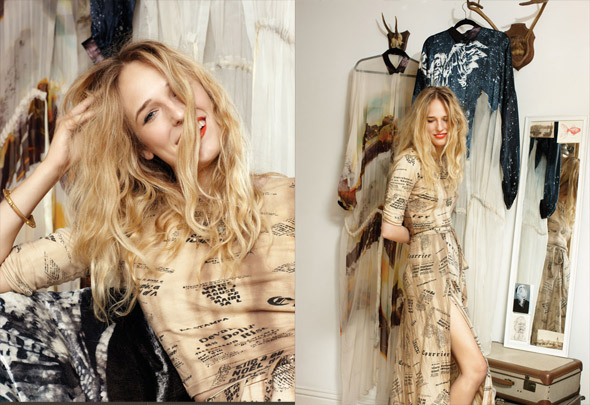
Photography: OLIVIA BEASLEY
Stylist: Sabrina Henry
Hair: Elliot Bssila at DWM
Make-Up: Marco Antonio at DWM
Model: Leila Jay at Select
Shot at: Masonic Temple,
Hyatt Andaz, London
Annabel Luton is a Fashion and Print Design graduate from Central Saint Martins in London. Her final collection’s silhouettes, mysterious birds, and scenic prints are inspired by Mata Hari – the Oriental dancer, part time spy and femme fatale of the 1900s. While studying, Annabel interned at John Galliano and worked closely with the famous print designer, as well as at
the Diane von Furstenberg headquarters in New York, and with the Felder Felder twins in London.
Your final collection was inspired by Mata Hari – part spy, part vixen. How did you first come across that as your inspiration?
Prior to my final collection I did a pre-collection and looked into a tribe called Miao from southwest China. My collection started looking very tribal, so I needed to find a character to set the scene. After days of researching and talking to people about my quest for this mysterious character, I finally came across Mata Hari. I had conjured up this amazing image of her in my head, and when I finally looked at a photo, it matched my expectations. The [1931] movie, which stars Greta Garbo, was also one of my inspirations for its costumes and scenery. That was how it all started really.
Did you stumble across any other cultural references through the tribes or was it mainly Oriental?
The tribes that I first looked at were mainly Oriental; they did a lot of work by hand, such as weaving, and made really luxurious fabrics. There’s this wonderful fabric made out of indigo which they beat until it shines; it’s a process called calendering. I took some from the original tribe and featured it in my final collection, but I kept the prints faded and mottled to look old, creating contrast against the luxury.
What techniques did you use?
Everything in this collection is hand-drawn and hand-dyed. To achieve the mottled effect I cut big stencils out of acetate sheets and sponged them on in different layers, and then screen-printed another layer on top of it to get the faces of the birds, etc. The night sky behind the birds is done with batik wax dots, so I dripped wax onto fabric and then dyed it, then ironed the wax off. There’s quite a lot happening in all of it.
What were your other inspirations for the collection?
They all evolved with time, and experimenting. I usually get a story in my head and allow it to evolve rather than looking at different things. For example, the night sky evolved from Mata Hari’s mystery.
What sort of people, apart from Mata Hari, do you see wearing your clothes?
Someone that’s quite confident and quite young, I suppose, but also likes experimenting and layering [with clothing]. I designed this collection for someone like Mata Hari to wear… [she] was the inspiration for everything.
How would you say you develop your style? A lot of people ask me what my style is, and it’s quite a hard question to answer – are you even meant to have a style?
I take inspiration from everywhere – markets, galleries, clothes you see around you, people on the streets, blogs… anything. When looking for inspiration, there’s so many ideas that it’s difficult to decide which path to take. But when you lay everything out on the floor you realize what you’re most attracted to, and usually all the images that you pick out relate to each other in some way. That’s your style.
You interned at Galliano and Felder Felder – what did you take away from that experience?
I learned so much in that year – how to experiment, how to put a collection together… it opened me up to so many different techniques. The most important thing I learned is that not everything needs hundreds of meanings behind it. It’s good to have some meaning, but at the end of the day it has to be wearable. I worked closely with the print designer at Galliano – and that was when I realized that this was what I really loved doing.
What do you think of the current state of the fashion industry – is there really space for new designers?
People like individual pieces from small young designers, which is the way I think the market can expand. The only problem is the funding for new designers and how much money it’s going to cost them. That’s the deciding factor, especially with the situation we’re in at the moment. I suppose out of every bad situation a lot of creativity arises…it is hard work though.
If you were in control of the fashion industry, how would you change it so that fashion is perceived the way you think it deserves to be?
In London, there are so many amazing young designers, and I don’t think there’s enough focus on them or help offered. If I was in control, I’d try and make it easier for these designers. For example, the Parisian government gives grants to designers and that explains why they have thriving businesses in England… I’d probably do something like that for young designers in London – this is where I think the up and coming fashion is.
What’s your most memorable piece of clothing?
It doesn’t relate to my collection now at all, but I’m half Norwegian and my mum and grandmother have the traditional dress, which is like a national costume. They each have one that relates to the town where they came from, embroidered differently or in different colors. Those have been around my house since I was a child.
Who are your favorite designers?
My favorite label as a whole is Prada. I like Dries Van Noten and Christopher Kane; both have really interesting print ideas. Print is definitely growing as a lot of these labels are doing it at the moment.
What would you say makes a print collection stand out?
Things that don’t look obviously digitally printed. I like designs which are really intricate and that show the amount of hours that someone has spent on it, like prints that are layered. I find photographic print disappointing; it’s simply taking a picture of someone else and blowing it up on a T-shirt. I have to admit I’m a sucker for it, but people appreciate it more when it’s handmade.
Will you employ similar techniques in future collections?
Every collection that I do will include that print. What I really thrive on is coming up with weird techniques and introducing new handy-work with clothes. I quite like simple shapes, so I experiment with different things such as weaving or print. I like the silhouettes from the clothes to flow and have a lot of movement. That, combined with the print, makes a statement when someone walks into a room – which is what I’m aiming for.
Definitely! So what are you working on right now… what’s next for ‘Annabel Luton’?
At the moment I’m freelance but I’m also working with a print designer (whose name I’m not allowed to say). I want to start my own thing and continue designing, but that will come with time. I’m going to do a new collection in a few months try and work on that and see where it takes me. Fashion means a lot to me because it’s what I love doing, and it makes a lot of people feel good, but I’m not that self obsessed with it. It’s hard
to say that it means everything because at the end of the day, it is
just fashion.
– Katia Ganfield
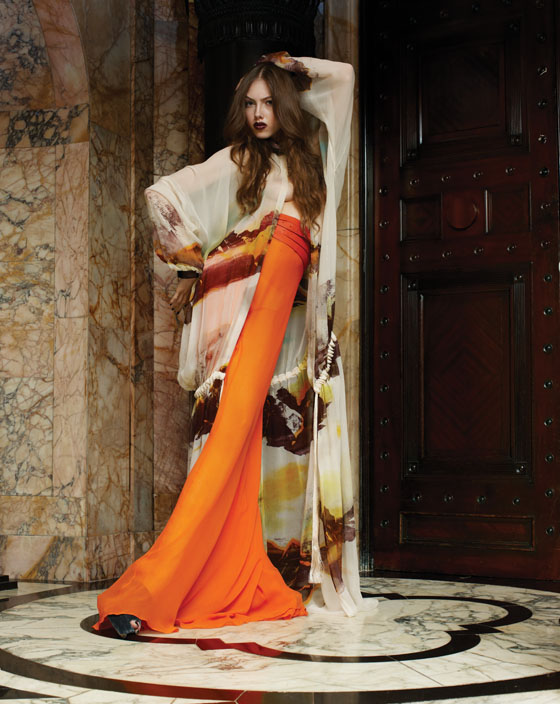
Mountain print maxi shirt, orange silk trousers, the ‘3-meter’ belt and velvet platforms
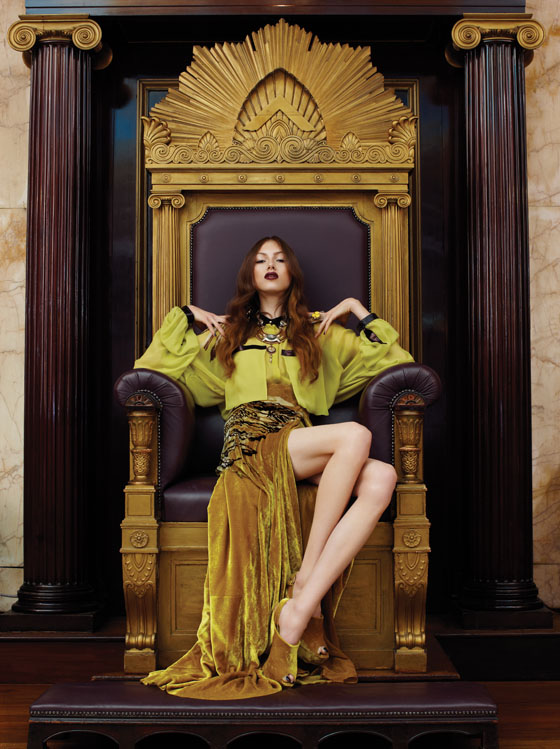
Silk bird shirt, velvet owl skirt and velvet platforms, all price on request,
Perspex, hand painted stone and Swarovski crystal earrings, perspex and hand painted stone ring, Erickson Beamon “Cowboy Junkie” antique gold plate necklace with gold flecked stones
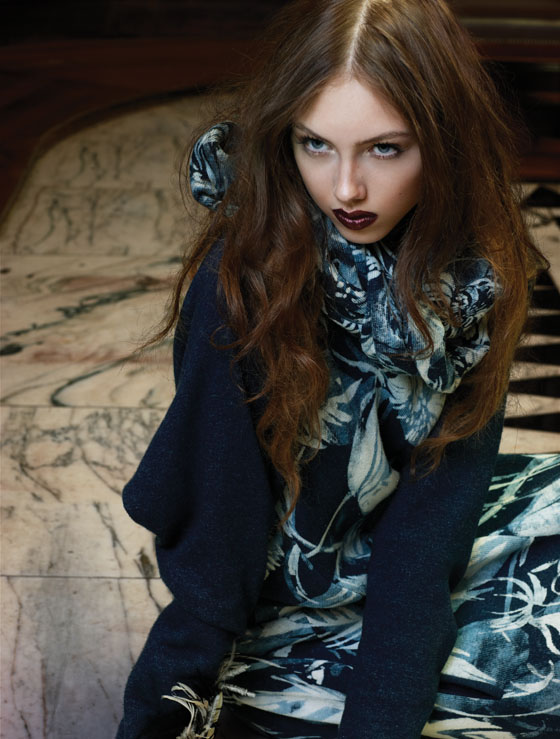
Bleached floral sweater dress and bleached floral joggers (worn as scarf)
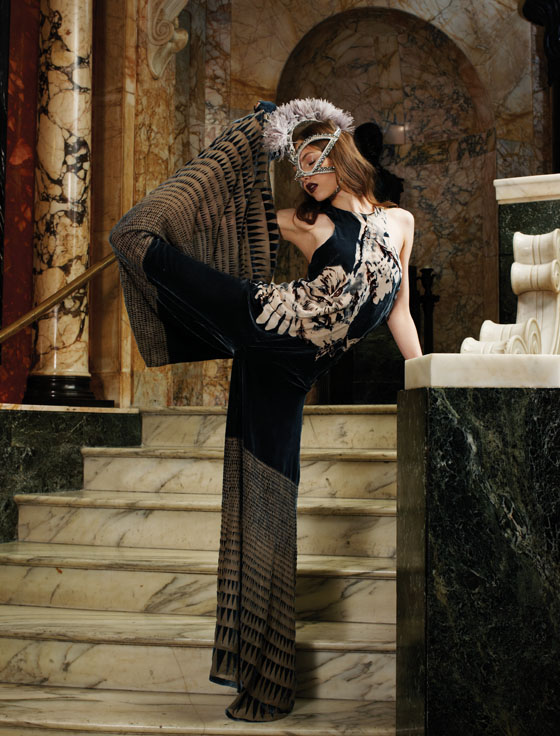
Devoré owl jumpsuit “Mistress Masquerade” Swarovski crystal bespoke head piece, Erickson Beamon velvet platforms

